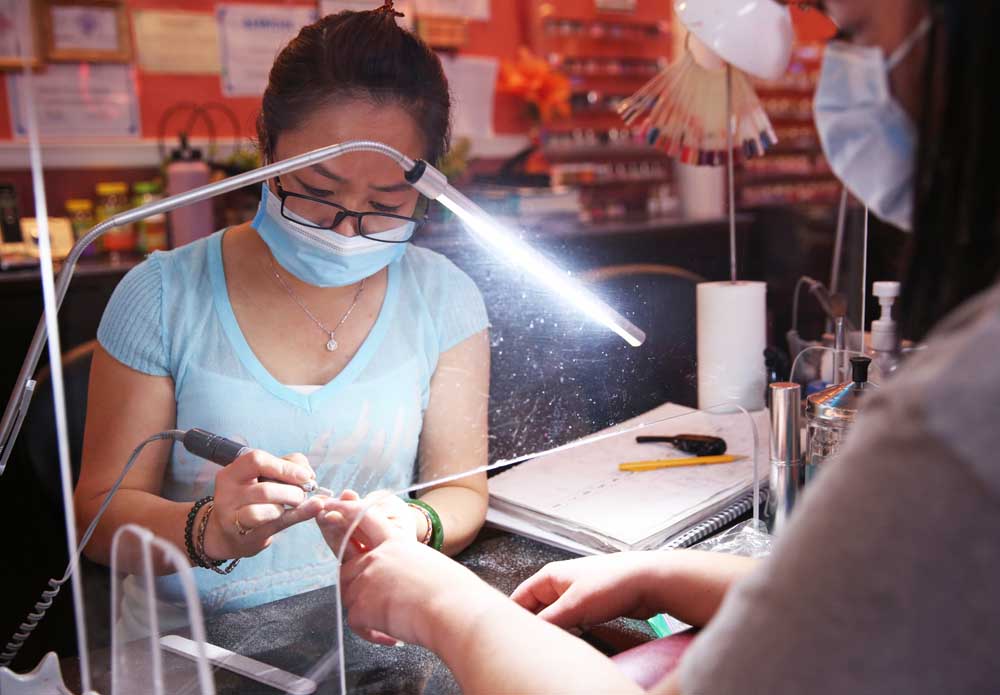Salons, barbershops survive on razor-thin margins
Published 5:00 am Sunday, August 23, 2020

- Kim Vu, co-owner of Pro Solar Nails, left, gives a manicure to Hannah Cashman of Bend.
Five months ago, Kim Vu closed her nail salon shop in southwest Bend to comply with Gov. Kate Brown’s order to shutter nonessential businesses. Today her business is up and running again but the restrictions mandated by the state have made profit margins a thing of the past.
“We can’t take a lot of clients at the same time, so it’s a little hard for me. The income is not like last year, we are down more than 30% compared to last year,” said Vu, owner of Pro Solar Nails in Pinebrook Plaza.
Vu is among hundreds of small business owners in Central Oregon struggling to regain their footing during the age of COVID-19 restrictions. The rule changes led to record job cuts and a downturn in business in some sectors where close contact with other people is unavoidable.
Phase 2 led to reopenings across the state for many businesses but with limitations on the number of clients that can be present at any given time. Hairdressers and nail salons are particularly vulnerable to the restrictions. To protect both employees and clients, masks are worn and clear barriers have been erected in key locations. At some salons, including Pro Solar Nails, temperatures are taken at the door and customers must fill out a contact sheet.
The limit on customers has caused a downturn in revenue for Pro Solar Nails, said Vu. She tries to keep the number of workers in the shop to six, including herself and her husband, who helps out. Pre-pandemic, as many as eight employees were in the salon.
“We still have some people not coming yet because they are worried about COVID. So we don’t have enough clients coming back,” said Vu. “But we are limiting the people in the salon, and we are adhering to all safety regulations.”
The extra personal protective equipment increases the cost of doing business, said Troy Batson, owner of Bond Street Barbershop. Barbers change shirts frequently, there is extra sanitation on anything that is touched, and clients are supplied with a new cape between uses.
Batson said he bought 300 capes when the shop reopened, and today the shop still goes through 75 masks a day.
“All that is eating into the profits,” said Batson. “The PPE we provide has made it more expensive to cut hair. We hope it will be temporary.”
Revenue is also down at the barbershop because the masks limit the beard work that can be done and prevent shaves altogether.
“We just cut hair and do little beard work,” said Batson. “A lot of people are learning how to trim their own beards.”
Batson said revenue could increase by going back to normal hours of 5 a.m. to 7 p.m., but some of his employees are staying away from the shop out of coronavirus concerns, coupled with federal benefits. Without more barbers in the shop, he has curtailed hours to 8 a.m. to 5 p.m.
“They are concerned. They don’t want to come back and put their family at risk. And the way they are paying them these days, some make the same (income) just sitting at home,” said Batson.
Changes in the way business is done since reopening has cut profits by 20%, said Batson.
While individual shops may be seeing revenues trimmed, employment numbers have ticked up in the salon and barbershop business since the lockdown ended in May. Around half the jobs that were lost have come back in the “other services” sector that includes barbers and salons, said Damon Runberg, Oregon Employment Department regional economist.
“Moving into Phase 2 has led to a strong rebound as restrictions have eased,” said Runberg. “The long-term outlook for these kinds of personal services remains positive as the expectation is that consumers will go back to normal levels of personal service consumption once people feel safe and secure.”
The economy overall is also showing signs of progress. New unemployment claims reported earlier this month for the state of Oregon fell back to pre-pandemic levels — just 4,600 claims were filed for the week ending Aug. 8. That’s a significant drop from March when claims topped 75,000 per week, three weeks in a row.
Republican lawmakers say more Americans will return to work if weekly unemployment incentives created by the CARES Act stop or are significantly curtailed. Democrats want benefits to remain at $600. The benefits expired last month, and Congress has yet to decide on an extension.
“Our five barbers are still busy, only at a staggered shift,” said Batson. “Some work in the morning, some come in the afternoon. But we have been busy; people’s hair continues to grow.”
For Vu at the nail salon shop, it’s not a matter of hiring more workers. She held off on hiring back temporary workers because there just isn’t space for more people while respecting the social distance guidelines.
There’s no quick fix to the revenue shortfall except to keep a steady stream of customers coming through the door, and that requires building trust around safety and cleanliness.
“We will try to do the best we can to keep the business going,” said Vu. “We try to get more people in and run our business with safety and cleanliness as our priority. If more people come, we make more income and we can stay open.”






